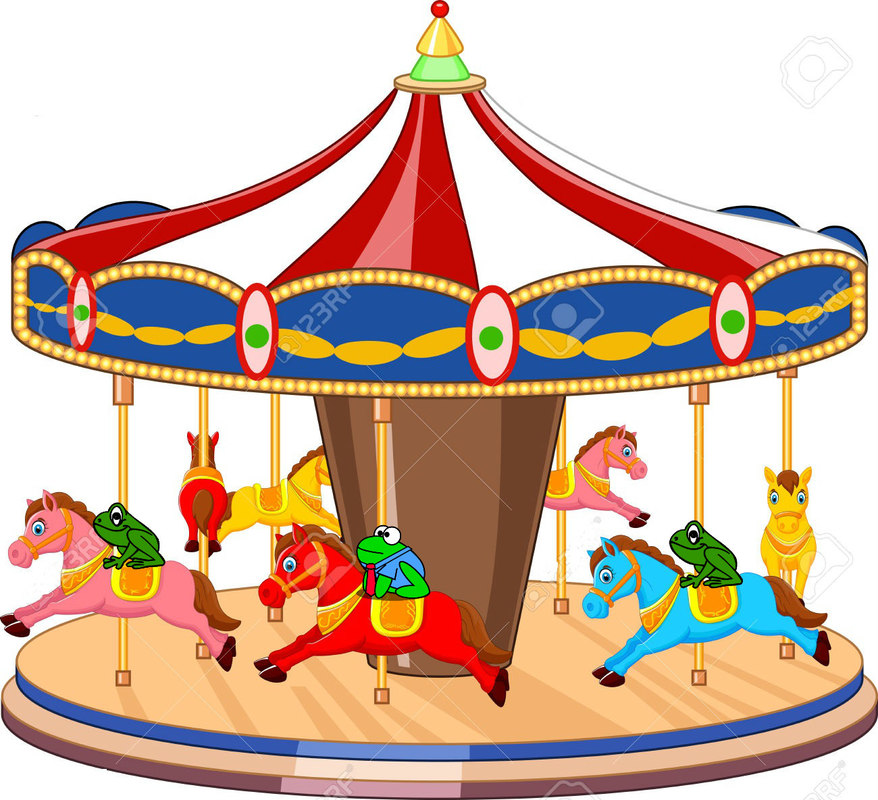The merry-go-round, also known as a carousel (France) and roundabout (UK), is an amusement ride that consists of a rotating circular platform with seats for its riders. The seats, generally in rows, are made up of beautifully-painted wooden, aluminum, or fiberglass horses (other animals are also used) that are mounted on posts that go up and down to simulate the running and galloping of the animals. Circus music plays as the platform turns round and round. In the good ol' days, the music was played on a steam calliope. The animals all had wonderful names like Thunder, Galloper, Jumper, and Horeseabout. Just ask any kid, and they'll be quick to tell you which is their favorite one to ride. Each horse or animal roughly weighs 100 pounds (45 kg).
Any rotating platform can be called a merry-go-round. The simple ones found in your neighborhood playground are kid-powered; the children run, pushing the platform, and when it gets up to a good fast speed will hop on and ride it until it slows back down.
The modern carousel evolved from early jousting traditions in Europe and the Middle East. Knights would ride horses in a circle tossing balls from one to the other, an activity that required great skill and horsemanship. This game was introduced to Europe at the time of the Crusades. The term carousel originated from the Italian word garosello and the Spanish word carosella which means "little battle" a term used by the Crusaders to describe a combat preparation exercise. By the 17th century, the balls had been dispensed with and, instead, the riders had to spear small rings that were hanging from poles overhead and rip them off. Calvary spectacles that replaced medieval jousting, such as the ring-tilt, were popular in Italy and France. These games became popular with commoners and soon carousels soon sprang up at fairgrounds all over Europe. At the Place du Carrousel in Paris, an early make believe carousel was set up with wooden horses for the children.
By the early 18th century, carousels were being built and operated all across central Europe and England. The animals and mechanisms would be crafted during the winter months and the family and workers would go touring in their wagon train throughout the region in summertime, operating their large menagerie carousel at various venues and fairs. These early carousels had no platform, but the animals were hung from chains and would fly out from the centrifugal force of the spinning mechanism. They were, in the beginning, powered by live animals walking in a circle or by people pulling a rope or or cranking.
In the UK, roundabouts turn clockwise, while in North America and Europe, they revolve counterclockwise, as viewed from above.
By the mid-19th century, the carousel platform had been developed and the animals and chariots were fixed to the circular floor that would suspend from a center pole and rotate around. This version of the carousel, called dobbies, were operated manually by a person or by ponies. The first steam powered carousel was debuted at Aylsham Fair in the UK, around 1861. Soon afterwards, engineer Frederick Savage branched out of agricultural machinery production and into the production and construction of fairground machines. He rapidly became an innovator in the field. In the United States, the carousel industry was developed by immigrants, most notably Gustav Dentzel of Germany and someone named Dare, from England, in the late 19th-century. In the 1840's, Franz Wiesenoffer created the first merry-go-round in the United States in Hessville, Ohio. July 25th, 1871 marked the very first carousel patent issued in the US. (And thus the reason for today's celebration!)
The best way to celebrate this fun holiday is to, of course, find a carousel and just have fun riding it. It needn't be a big fancy one at the amusement park, although those can be very special. Nearly every child's playground has one, though, and they're just as much now as they were years ago when you first pushed one around. Go ahead! Be a kid today and have a little fun! You deserve it. And don't forget to use #MerryGoRoundDay on all your social media.
This afternoon, I'm taking little brother Quigley, and his BFF, to the Lily Pad "Hop On Board" Amusement Park for a day of fun....riding round, and round, and round. (I hope no one grabs my favorite horse named Jumper!)

 RSS Feed
RSS Feed